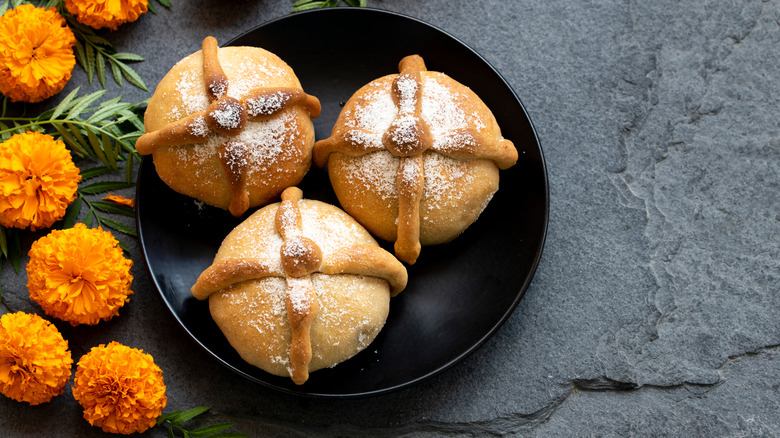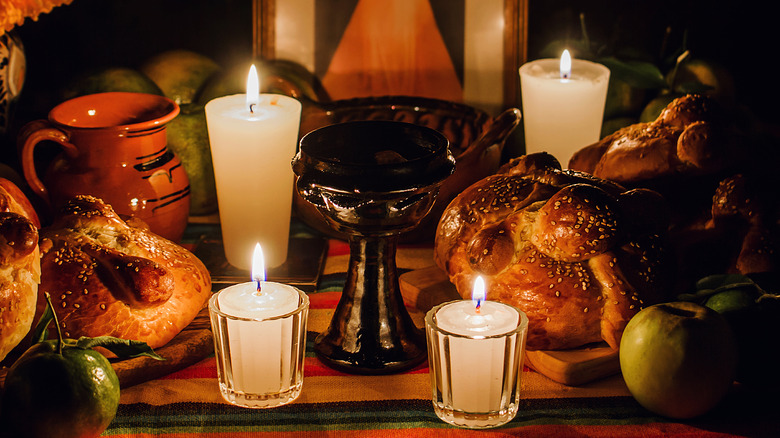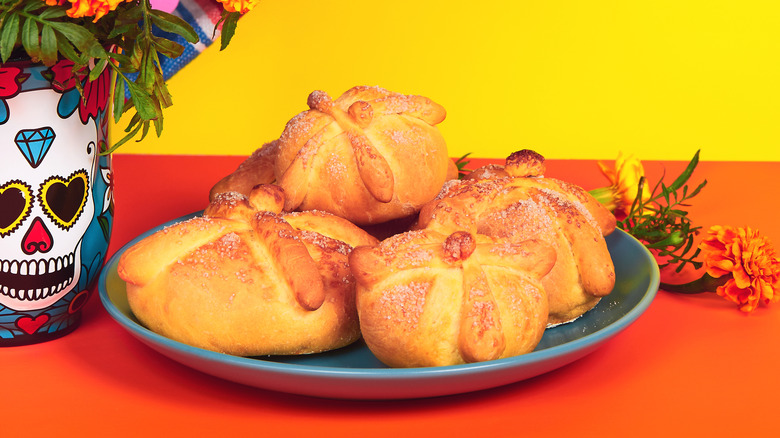The Delectable Mexican Bread That's A Dia De Los Muertos Staple
Most holidays center around some type of food, and the Dia de Los Muertos (Day of the Dead) is no exception. Celebrated every November 1st and 2nd in Mexico, the United States, and other parts of the world, this holiday serves as a time to remember lost loved ones (via History).
Traditionally, the celebration involves costumes, parades, vibrant decorations, and other festivities, along with various foods. But, there's one food, in particular, that's considered a staple for this two-day holiday – pan de Muerto (bread of the dead).
Adriana Velez of The Washington Post describes the bread as a "sweet, rich, pillowy-soft dream fragrant with star anise, orange zest and orange blossom water." The sugar-dusted, round-shaped bread also traditionally features a criss-cross pattern and a rounded knob-like top at the center of the loaf.
So what's so special about this bread of the dead, and why is it such an important component of the Dia de Los Muertos?
Pan de Muerto is traditionally used as part of an offering
According to History, the Dia de Los Muertos dates back 3,000 years in pre-Colombian Mesoamerica, when people honored the dead with rituals. These rituals eventually led to the same actions performed today, including creating intimate altars in homes and leaving food and other offerings on gravesites. The reason for these actions stems from the belief that the spirits of the dead will return to enjoy the offerings.
Born and raised in Mexico, Mexican food blogger Mely Martinez shared some insight on these food offerings in her Mexico in My Kitchen blog. Traditionally, when gathering the items for an offering, you would choose the food and beverages that the deceased person loved. Martinez also added that a loaf of pan de Muerto is also placed with the offering as a form of nourishment.
Adriana Velez claims in her The Washington Post recipe that the bread "calls forth the souls of the dead" and is a "gift to the beloved departed, a mediation for the living." She also states that dozens of versions of pan de Muerto exist, but the round shape is the most common. Mexican Food Journal states that there are hundreds of varieties and that each region of Mexico has its version, some of which use other shapes like angels and sheep.
The symbolism of each part of pan de Muerto
Focusing on the most popular round shape of pan de Muerto, each portion of the loaf represents an important element, but interpretations vary by region, as The New York Times explains. According to Mexican Food Journal, the shape signifies the circle of life and death. Each piece of the criss-cross pattern represents bones, and the center nob-like top portion represents the skull of the deceased. However, as explained in Mexico in My Kitchen blog, some people believe it symbolizes tears while others believe it symbolizes the heart.
Mexican Food Journal claims each direction of the criss-cross pieces (the bones) indicates a cardinal point on a compass. One point represents the God of light and wind while another symbolizes the God of death and rebirth. The other two represent the God of rain and storms, and the God of darkness and sorcery.
Although there are many varieties of the delectable Mexican bread, the overall symbolism of pan de Muerto is the same for everyone who celebrates the Dia de Los Muertos; the bread is used as a part of an offering for lost loved ones to provide sustenance for the visiting soul.


